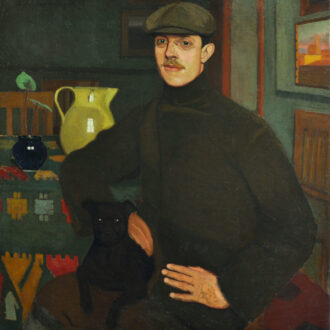Biografie
BIO
Livorno, August 30, 1879
Florence, 1 October 1949
Of Welsh origin, he took his first steps in the city of Labron in the school of Guglielmo Micheli with Amedeo Modigliani, Oscar Ghiglia and Gino Romiti. The best of the group attracted the attention of Giovanni Fattori, and Lloyd was one of those invited to the Accademia di Belle Arti in Florence. Here he came into contact with the Florentine milieu where Macchiaioli painters such as Telemaco Signorini and Adriano Cecioni were setting the tone, and he came closer to studying 15th-century Italian art.
His first painting phase was characterised by a stylistic conservatism with softened tones, capable of combining classical tendencies and modern aspirations. It was, however, the influence that Plinio Nomellini exerted on him that brought him into the wake of Divisionism, a style that he developed over time, using Liguria (the Cinque Terre) and Tuscany (the Pisan and Livorno countryside) as natural settings.
He then became one of the leading exponents, together with Plinio Nomellini, Benvenuto Benvenuti and Guglielmo Amedeo Lori, of what was later defined as Tuscan Divisionism. The infatuation was short-lived, however, so much so that by the time of his stay on the island of Elba, he had already shown a change of direction in his painting, which brought him back onto more conventional tracks.
The next thirty years took place in a crescendo of artistic emotions, produced by the large number of exhibitions in which he participated.
In 1929, he also found the time to compose an important essay on the history of art, La pittura dell'Ottocento in Italia (Nineteenth-Century Painting in Italy), in which he celebrated the figure of Giovanni Fattori and dwelt on the debt virtually incurred by the artistic avant-gardes (Expressionism, Cubism, Futurism, etc.) towards the Tuscan (Sienese) primitives of the 15th century.
Llewelyn Lloyd's painting career ended in 1944, when he was interned in the Fossoli concentration camp and then in Bavaria, due to his Welsh origins. However, he was able to return to Italy in 1945, where he died in Florence.
Bibliography
- Llewelyn Lloyd, Tempi andati, edited by Dario Matteoni, Florence, L. S. Olschki, 2007.
- Lucia Mannini, Llewelyn Lloyd e l’eredità della Macchia, in “Artista. Critica dell’arte in Toscana”, 2001, Casa Editrice Le Lettere, Florence,
- Raffaele Monti, Il divisionismo toscano, Edizioni De Luca, 1995
